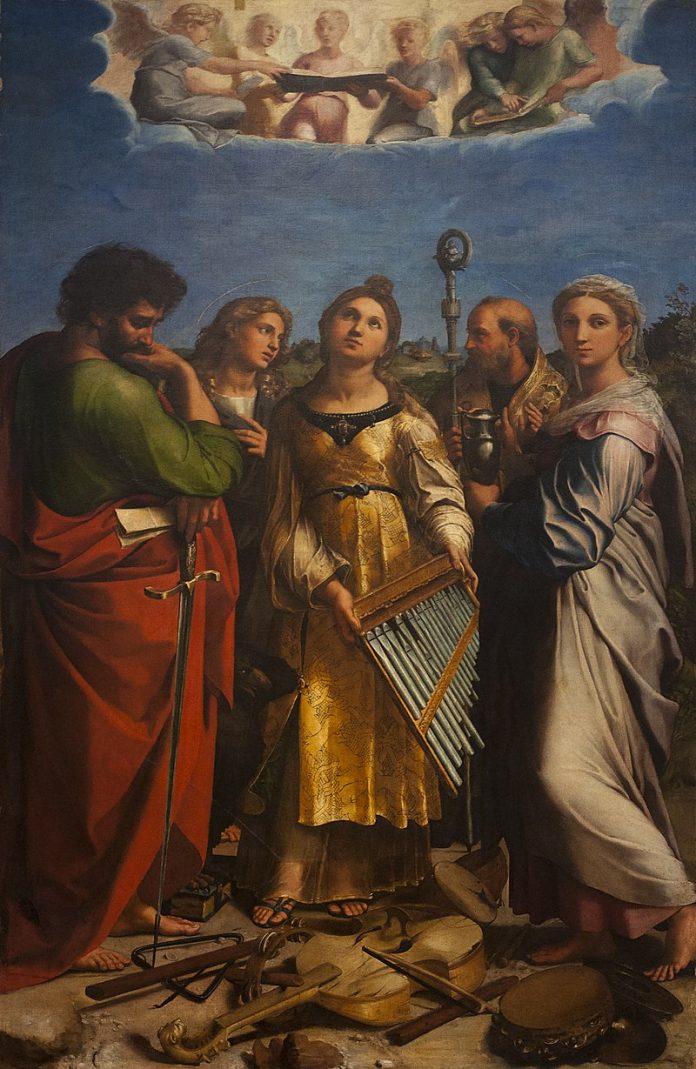We have to wait to hear what heavenly music sounds like, but Saint Francis de Sales once recounted that he was blessed to hear an angel played one note on a violin – of what material it was made we may only surmise – and said it was the most beautiful sound he could remember.
What we may be sure of is that today’s saint, Cecilia, is the heavenly patroness of Church music, and music in general. Given the current state of both, she has her intercessory work cut out for her. A young virgin martyr in Rome, put to death for her Christian beliefs sometime between 225 and 235 A.D. Refusing to recant her Faith, she was struck on the neck three times with a sword, after which she lived for three days.
Just prior to her entrance into heaven, she was married, against her will, to a pagan husband, Valerian. During the ceremony, she sat apart, ‘singing in her heart to the Lord‘, to console herself. For that one phrase, she was adopted as the patroness of music. On their wedding night, Cecilia told her husband that she had been consecrated to God, and an angel was watching them who, were Valerian to violate her, would be much displeased. But if he were to respect her virginity, he would gain heavenly favour. Valerian asked to see the angel, and Cecelia said he could, if he went to the third milestone outside Rome, and was baptized by Pope Urban I. To his credit, Valerian did so, saw the angel, and lived with his wife ‘as brother and sister’. Soon enough, he, Cecilia and her brother were all martyred together. Catholics lived much closer to eternity in those early days of persecution.
So the story goes. What we do know for certain is that Cecilia is one of the most venerated of martyrs, with churches around the world dedicated to her, along with choirs, societies, and people – Sheila is the Gaelic version of her Roman name. When they exhumed her body in 1599, Caecilia was found incorrupt, seeming to be asleep, waiting for that eschatological trumpet blast, which will likely be somewhat louder than the angel’s violin.
Vatican II has this to say about Church music in its Constitution on the Sacred Liturgy (Sacrosanctum Concilium):
The musical tradition of the universal Church is a treasure of inestimable value (pretii inaestimabilis), greater even than that of any other art.
That is saying something, given the ‘inestimable value’ of all the rest of the Church’s art, paintings, buildings, sculptures, mosaics, vestments, chalices and so on and on, ad maiorem Dei gloriam. Yet how much of that ‘musical treasure’ remains locked away, all the chants, the motets, the glorious traditional hymns, with their rhythmical and deeply theological Latin poetry, gathering dust as the ages go by?
The main reason for this pre-eminence is that, as sacred song united to the words, it forms a necessary or integral part of the solemn liturgy.
The value of the Church’s music is not something it holds on its own, but rather as part of the public worship of God in the Liturgy. Without music, such worship is lessened and attenuated, although simple ‘said’ Masses – low Masses in the usus antiquior – are fine in their proper place.
What the Church does not allow is music in Liturgy that is secular and worldly, or that is tawdry, banal or self-centred. As Sacrosanctum continues:
Therefore sacred music is to be considered the more holy in proportion as it is more closely connected with the liturgical action, whether it adds delight to prayer, fosters unity of minds, or confers greater solemnity upon the sacred rites.
There is a gradation in ‘good’ Church music, from the most perfect, to the lesser so, to the stuff that should never be heard anywhere near a Church. As Saint Pius X put it so clearly in his 1903 Motu Proprio, Tra le Sollecitudini, just months after being chosen as Pope:
Sacred music should consequently possess, in the highest degree, the qualities proper to the liturgy, and in particular sanctity and goodness of form, which will spontaneously produce the final quality of universality.
It must be holy, and must, therefore, exclude all profanity not only in itself, but in the manner in which it is presented by those who execute it.
And, to further clarify the point, in case might think 1970’s or our more current ‘charismatic’ guitar ballads fit the bill, or whatever their equivalent might have been at the turn of the century:
On these grounds Gregorian Chant has always been regarded as the supreme model for sacred music, so that it is fully legitimate to lay down the following rule: the more closely a composition for church approaches in its movement, inspiration and savor the Gregorian form, the more sacred and liturgical it becomes; and the more out of harmony it is with that supreme model, the less worthy it is of the temple
Ecclesiastical music should be ‘holy’, should lift our hearts and minds above and beyond the secular world, into the consecrated spiritual oasis that is the Liturgy, and especially the Holy Mass.
God in His wisdom and providence has given us such music, set aside – made sacred – for such a purpose, that goes back to the very dawn of the Church:
The Church acknowledges Gregorian chant as specially suited to the Roman liturgy (ut liturgiae romanae proprium): therefore, other things being equal, it should be given pride of place (principem locum) in liturgical services
Remember, this is Vatican II. Notice the term ‘specially suited’, which in the original Latin is ‘proprium‘: Gregorian chant is proper to the Roman liturgy, which means it belongs there as part of its very nature, and something is sorely missing without it.
Of course, other kinds of music add also to the splendour of the Liturgy, “especially polyphony” as the document states, or, to return to Pius X:
The above-mentioned qualities are also possessed in an excellent degree by Classic Polyphony, especially of the Roman School, which reached its greatest perfection in the sixteenth century, owing to the works of Pierluigi da Palestrina…
Ah, yes, the great Palestrina, but we may include the later Bach, Mozart, Tallis, Byrd and Vivaldi, whose music is heard, sadly, now by and large only in secular concert halls, or in churches – usually Protestant, or abandoned de-consecrated spaces – outside of Liturgy.
And what of instruments?
In the Latin Church the pipe organ is to be held in high esteem (magno in honore habeatur), for it is the traditional musical instrument which adds a wonderful splendor to the Church’s ceremonies powerfully lifts up man’s mind to God and to higher things.
One wonders why so many organs – many of them priceless – have been forcibly removed from churches, gutted from the choir lofts, or left to languish, un-played, as they fall into atonality and ruin. As the great J. S. Bach put it – a Lutheran, but in many fundamental ways with more Catholic sensibilities than most in that age of religious strife – the organ is the ‘instrument of instruments’, requiring years of dedication to play to full effect. Yet how many churches pay their secretaries and maintenance men well, with full benefits, but hire no one to play and direct music? Should we not strive for music ministers whose talents extend somewhat beyond four or five chords on a guitar, making up in volume and pathos for whatever else is lacking?
If music is the most important accoutrement to Liturgy – that thing which gives it its greatest beauty and attraction – should we not devote more time and effort and, yes, money, to it?
In Church, no music is better than secular or bad music. There are many other charisms in the Church besides music ability, and glorious silence – so missing in modern Liturgy and life – is better than listening to banality or, worse, a cacophany.
There is a phrase attributed to Saint Augustine, ‘qui bene cantat, bis orat‘, he who sings well, prays twice. (What the bishop really seems to have said was something to the effect that he who sings with love prays twice, but that is another story).
The Constitution does allow that “other instruments also may be admitted for use in divine worship”, but “only on condition that the instruments are suitable, or can be made suitable, for sacred use, accord with the dignity of the temple, and truly contribute to the edification of the faithful“.
The ‘apt for sacred use’ implies that such ‘other instruments’ should not be those we hear in the secular realm, drums, guitars, banjos, worse if amplified, even if there be nothing wrong – and much right – with them in their own right time and place.
Rather, music and its instruments should be ‘liminal’, allowing us, the listeners, to transcend the ‘threshold’ of the passing form of this world, giving us a brief glimpse of heaven, fitting for the dignity of God’s temple, leading us to holiness. How often have we left Mass un-edified, emotionally drained, and all-too-un-exalted, forced to discern with the sheer force of our intellect and will the great beauty of the Liturgy obscured by what now passes for ‘Church music’? As one musician recently put it, and I paraphrase, we are leaving the expensive china and silverware in the cupboard, and serving up the best dishes to God and His people on musical styrofoam and paper plates.
So, dear reader, please do strive in your own way to re-appropriate the great and inestimable musical treasure of the Church, by attending good Liturgy, getting involved yourself, learning how to sing and play, and at least learning to appreciate all that is true, good and beautiful in the music handed down to us through the ages of the Church’s great Tradition. Doing so may be a bit of work, at least at first, but one that is well, well worth the cost.
Sancta Caeceila, ora pro nobis!











